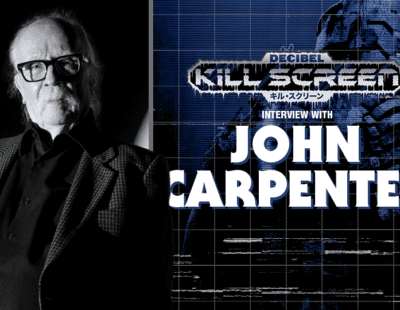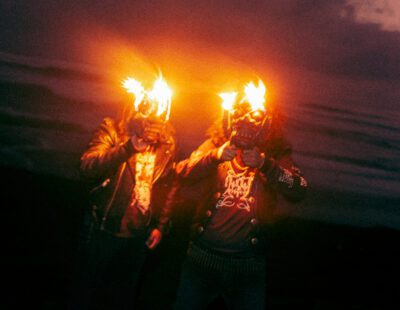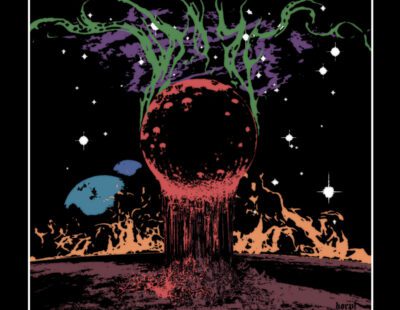
Haavard is the beginning of a long-story journey of one of black metal’s most notorious players, Håvard Jørgensen, aka Lemarchand. Once a critical member of Satyricon and Ulver, Jørgensen’s metal-related musical life took a backseat for a good 15 years. Not that his involvement in Ulver’s Kveldssanger was by any stretch of the imagination metal, but the build-up in the form of Satyricon’s pre-album work and Ulver’s storied discography up to Nattens Madrigal – Aatte Hymne til Ulven i Manden was.
Haavard, in almost every respect, is the continuation of Jørgensen’s introspective lays on Kveldssanger. To wit, there’s homage to said work on the Haavard track, “Kveldssang II,” as well as the inclusion of musical peer/friend Kristoffer Rygg (aka Garm) on “Mot Soleglad.” There’s a distinct air of nostalgia in these two tracks, as if 1996 had life again, but only in memory. Outside of Haavard land-lining to old brothers, he’s striking new (mostly) acoustic chords in the form of “Printemps” (embed below), “The Chase,” “Niende Mars,” and “Heartwood” by bringing in flute, violin, viola, cello, accordion, and more. To accomplish that he brought on a cadre of friends like Tore Ylwizaker (Ulver), Anders Møller (Ulver), Evan Runge and Raphael Weinroth-Browne (both Musk Ox).
Venture into the forests, lakes, streams, waterfalls, and mountains of Jørgensen’s mind. Certainly, there’s a strong Norwegian sentiment/aesthetic at play, but it shouldn’t matter if you’re not sitting in Myrdal, venturing through Lofoten, or gasping in awe atop Pulpit Rock. Haavard’s music will take you there (or to any other place of your imagination).
Tell me how Haavard got started. It had humble beginnings, if I remember correctly.
Håvard Jørgensen: That’s right. I think Haavard started way back. I’m not sure how far back, but certainly during Ulver’s non-metal days. Then, life got in the way. I had other priorities. I had to put my music away for a while, but in 2014, I was contacted by a Danish artist called Myrkur [aka Amalie Bruun] to do some acoustic guitars. Actually, I think it was Kris [aka Kristoffer Rygg] who asked me. So, while I was recording the acoustic guitar in the studio for Myrkur, I suddenly had some inspiration to write my own music. The first song I wrote had a working title called “Road to Recovery.” The name came to me as a way to recover some part of myself as an artist. I didn’t have any plans outside of recording it in my home. I made a YouTube video for it, and I posted it. I got a lot of feedback. One of the people who wrote to me was Prophecy Records. They told me that if I ever wanted to make a full-length, they’d like to release it. That got me thinking. So, I wrote some more. I hadn’t really concluded on releasing anything, but I continued to write. I can’t remember when I sent them a demo, but when they heard it they were really excited about it. They said, “Let’s do a full-length!” Finally, I had the chance to release my music on vinyl, which is something I hadn’t done in many years. I remember talking to Kris about it. He said I should definitely do it under my own name. One thing led to another, and I finally found myself with enough material for a full-length. It’s taken some time though–the recordings were finished at the end of 2017.
Where does Dold Vorde Ens Navn fit into the timeline of Haavard then?
Håvard Jørgensen: They coexist. Dolde Vorde is a band. We are equal partners in that band. With my own project, it’s just me; and it’s only my voice. They are two of the same but going down separate paths. As far as timing goes, I started Haavard in 2014. I think I had finished the demos for the Haavard full-length by the time I had started working with Kai [S. Halvorsen; aka Cerberus] on Dold Vorde. At that point, I really only focused on Dold Vorde. The EP for Dold Vorde came out in 2019. Everything had taken so long [with Haavard] and my focus, at the time, was on Dold Vorde that I kind of forgot that I had my own project ready to complete.
There’s a lot of talk about Haavard as the follow-up to [Ulver’s] Kveldssanger. Obviously, this is acoustic as was Kveldssanger, but “Kveldssang II” kind of points in that direction, at least on the surface.
Håvard Jørgensen: I know the label is using that for a lot of obvious reasons, but that wasn’t my first thought. I will say, me and Kris were joking about that. In reality, some of songs on Haavard could’ve easily been on Kveldssanger. I know Kveldssanger was an important album in Ulver’s early career. Of all the genres people call it, it’s really early neo-folk. That came naturally, actually. Haavard is my project. Kris is on one track [“Mot Soleglad”] for old times’ sake. There’s homage to Kveldssanger called “Kveldssang II,” but it’s not a follow-up directly. It’s more a relative, actually.
What I was worried about that when I first heard you were putting together a full-length was that it would be barebones–just acoustic guitar. I like that you’re building up layers with other instruments. There’s a real sense of cinematic tension in the music.
Håvard Jørgensen: I was terrified to bring something like this to the table after so many years. There are so many great artists out there now. When I started writing this all of a sudden there were a lot of metal bands putting out acoustic albums. I thought, “Well, I think I need to make a statement.” I figured I couldn’t just release a full-length of toned-down music. That’s my style though, you realize. I’m very much into the simpler aspects of music. For this album, it worked out great though. I liked the fact that I brought in more instrumentation to build things. It’s a grand tour. I do that in Dold Vorde, in songs and across the full-length. I wanted the same level of intensity in Haavard. Not sure if my next full-length will be toned-down or something grander.
I like that you’re bridging the Kveldssanger gap. More than that though, the tension and release are unique to Haavard. The expression is still economical, but there’s a lot of color to it.
Håvard Jørgensen: I agree. It’s been 25 years since we released Kveldssanger. Hopefully, I’ve evolved as a songwriter since then. [Laughs] I don’t see Haavard as flamboyant. It’s a statement–here I am!
The first thing listeners will think is that you’re writing music in a forest or on top of a mountain. I remember the early clips you posted looked that way.
Håvard Jørgensen: Well, the clip of me on the guitar was from my backyard. [Laughs] We live close to the forest, so… I can see how people would come to that conclusion. My main source of inspiration is tranquility, a sense of loneliness and solitude. If that means I’m in the forest or in the mountains then so be it. I’m not sitting on a mountaintop writing a song. That’s not realistic. Inspiration comes from a lot of places. For me, I’ve always been fascinated with beautiful melodies–melodies that hit something inside of me. It could be pop or metal music; if it moves me then I’m inspired by it. Often, if I close my eyes, I find myself in a forest or on a mountain. But I’m not actually there unless I’m taking photographs. I’m an aspiring nature photographer, too. I spend a lot of time with the forests and animals doing that. It’s therapeutic for me to be alone in the elements. I’m never thinking about melodies when I’m doing that though. Music comes after that, actually.
The album cover is a nature photograph. I assume that’s yours.
Håvard Jørgensen: That’s correct. Every photograph [in the layout] on the full-length is by me.
What kind of camera gear do you use?
Håvard Jørgensen: It’s a Sony full-frame camera. I’ve been taking photos of nature for a long time. I did have a 10-15 year break though. I didn’t do anything creative during that time. Now, I bring my camera everywhere I go. It’s an expensive hobby though. I have lenses for wildlife, lenses for video–lenses for everything! I couldn’t do without it. Looking at my camera, it tells me I can’t leave it on the shelf. It gives me a kick in the butt to get outside. It’s a good relationship to have.
You said you had to get out of the creative realm by choice?
Håvard Jørgensen: Yes, it was by choice. When we drifted off into more electronic stuff with Ulver, there was less for me to do. The last two Ulver full-lengths I was on didn’t really feature me as part of the songwriting. I just had guitar parts. I think Nattens Madrigal was the last Ulver full-length where I played a role in the songwriting. After that, of course, I needed money. I started to work a normal job like the rest of the world. Then, I had a girlfriend, then one kid, then two kids. Life, basically. OK, so during those years, I was creative, so maybe it’s not fair to say I had stopped completely. I worked with other bands as a hired gun. Then, I was in a pop-rock band with old-friends in 2012. My current girlfriend–not the mother of my kids–is also a musician. She wrote the music for that project. I translated her music into a pop-rock format. We released two singles, but then it kind of drifted away. So, I will say I was away from the metal scene for 10 or more years. But if I’m being honest, I think Facebook had a lot to do with me getting back into the metal scene. In 2008, people from around the world were contacting me directly. At that point, I had no idea what Ulver had done 10-15 years before that was important. I’m really glad the music stood the test of time for a lot of people. For me, starting again made sense. I had history to go on. I still had music in me.
I remember when Nattens Madrigal came out. Everyone was expecting Kveldssanger II, even if they were shocked by Kveldssanger itself. The concept of a black metal version of Simon & Garfunkel made sense. Then, Nattens Madrigal was the antithesis.
Håvard Jørgensen: [Laughs] That’s the genius of Kris. He was in the front seat of every decision that came with Ulver. He had already thought of the first three Ulver albums as a trilogy. Kveldssanger was a great recording period. All of it, save a few parts, was written on-the-fly in the studio. The studio was located above a subway line. We had to record at night. Luckily, I was young enough that I still lived at home. I could sit there all night long, drinking red wine, playing music. It was a great recording experience for me. I tried to do that with Haavard, too. Everything I’ve done myself. I love writing music like this. Of course, the true black metal fans thought Kveldssanger was shit, but that quickly changed. Nattens Madrigal kind of shut them up. I remember I had looked forward to that [Laughs]. Nattens Madrigal was a totally different kind of beast.
Do you think you’ll perform live with Haavard?
Håvard Jørgensen: It’s possible. I never played live with Ulver. For me, doing a couple of shows with Myrkur made me really nervous. After, I thought, “I’ll never do that to myself again.” With Dold Vorde, we’ve done three shows. I found out that I loved it! I actually love playing live now. I’m not saying I’m not going to perform with Haavard live, but it has to be done right. There’s a production involved with Haavard. It’s going to be expensive. I’m working on some ideas now–maybe something stripped down. Maybe I’ll do songs from Haavard and Kveldssanger. I’ve been asked by two festivals, and at the moment, I’m not signing anything. I need to prove to myself that I can do it my way, and that I’ll be satisfied with that. I need to be ready. If people are paying to see me, I need to be able to fit the charge.
** Haavard’s new album, Haavard, is out November 11th on Auerbach Tonträger, a Prophecy Records sub-label. Pre-orders for LP, CD, and t-shirts is HERE. Enter the twilight songs of Haavard…






